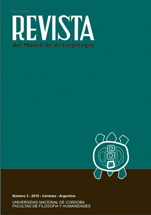Institutionalized movement: professional education of argentine folk dances
DOI:
https://doi.org/10.31048/1852.4826.v3.n1.5460Keywords:
dance, folklore, Argentina, teaching, peronismAbstract
In 1948 Argentina’s National School of Folkloric Dances was created as a part of Juan D. Peron’s “Quinquennial Plan”, launched during his first administration. Thus, the transmission and diffusion of folkloric dances as national symbols began to be professionalized, the development of which was accomplish by the instruction of a troupe of national dance teachers. This process required a repertoire based on the selection and transformation of those dances considered to be adequate expressions of Argentine nationhood, by means of choreography, music, clothing and events. Folklore, consolidating by the time as a scientific discipline, was functional to the national project, giving the criteria for the creation of a dance repertoire taught in Buenos Aires and expanded to the whole country. In this article we will describe the historical development that enables folkloric dances teaching institutionalization in Argentina, as well as the effects of such institutionalization. We will explore the rol that different groups or individuals from the political, cultural or academic realm attributed to the teaching of folkloric dances, during the process of nation-state building.Downloads
References
Archetti, E. 2003. Playing Football and Dancing Tango: Embodying Argentina in Movement, Style and Identity. En Dyck, Noel; Archetti, Eduardo (Ed.). Sport, Dance and Embodied Identities. Oxford, New York: Berg.
Blache, E. 1991. “Folklore y nacionalismo en la Argentina: su vinculación de origen y su desvinculación actual”. En Revista de Investigaciones Folklóricas 6 pgs. 56-66.
Buckland, T. J. 2006. Dance History and Ethnograpphy: frameworks, sources, and Identities of Past and Present. In Buckland, Theresa J. (ed.) Dancing from Past to Present. Nation, Culture, Identities. Wisconsin: The University of Wisconsin Press.
Chamosa, O. 2010. The Argentine Folklore Movement. Sugar Elites, Criollo Workers, and the Politics of Cultural Nationalism, 1900-1955. Tucson: The University of Arizona Press.
Degiovanni, F. 2007. Los textos de la patria. Nacionalismo, políticas culturales y canon en Argentina. Rosario: Beatriz Viterbo Editora.
Devoto, F. 2005. Nacionalismo, fascismo y tradicionalismo en la Argentina moderna. Buenos Aires: Siglo XXI.
Feldman, H C. 2006. Black Rhythms of Peru. Reviving the African Musical Heritage in the Black Pacific. Middletown: Wesleyan University Press.
Garramuño, F. 2007. Modernidades primitivas: tango, samba y nación. Buenos Aires: Fondo de Cultura Económica.
Gómez, S y L. Randisi. 2006. “Texto y Contexto: aportes para la comprensión del tiempo histórico y los cambios emergidos en instituciones de arte vinculadas con la enseñanza oficial del Folklore en nuestro país – Primera Parte”. En Folklore Latinoamericano. Tomo IX. Buenos Aires: IUNA Folklore.
Guss, D. 2000. The Festive State. Race, Ethnicity and Nationalism as Cultural Performance. Berkeley: University of California Press.
Hughes-Freeland, F. 2006. Construction a Classical Tradition: Javanese Court Dance in Indonesia. In Buckland, Theresa J. (ed.) Dancing from Past to Present. Nation, Culture, Identities. Wisconsin: The University of Wisconsin Press.
Kaeppler, A. 2006. Dances and Dancing in Tonga: Anthropological and Historical Discourses. In Buckland, Theresa J. (ed.) Dancing from Past to Present. Nation, Culture, Identities. Wisconsin: The University of Wisconsin Press.
Manners, L D. 2006. Utopia, Eutopia, and E.U. -topia. Performance and Memory in former Yugoslavia. In Buckland, Theresa J. (ed.) Dancing from Past to Present. Nation, Culture, Identities. Wisconsin: The University of Wisconsin Press.
Martín, A. 2005. “Introducción”. En Martín, A. (comp). Folclore en las grandes ciudades. Buenos Aires: Libros del Zorzal.
Martinez, I. L. 2002. Danzas Nacionalistas. The representation of history through folkloric dance in Venezuela. Critique of Anthropology, 22(3). 257-282.
Zoila, M. 2000. Shaping society through dance. Mestizo ritual perfomance in the preuvian Andes. Chicago and London.: The University of Chicago Press.
O’Shea, J. 2006. Dancing through history and Ethnography: Indian Classical Dance and the Performance of the past. In Buckland, Theresa J. (ed.) Dancing from Past to Present. Nation, Culture, Identities. Wisconsin: The University of Wisconsin Press.
Pujol, S. 1999. Historia del Baile. De la milonga a la disco. Buenos Aires: Emecé.
Reed, S. 1998. The Politics and poetics of dance. Annual Review of anthropology, Vol 27, 1998. pp. 503-532.
Rojas, R. 1909. La Restauración Nacionalista. Informe sobre Educación. Buenos Aires: Ministerio de Justicia e Instrucción Pública.
Vega, C. 1981. Apuntes para la historia del movimiento Tradicionalista Argentino. Buenos Aires: Instituto Nacional de Musicología Carlos Vega.
Vega, C. 1986 (1952). Las danzas populares argentinas. Tomo I. Buenos Aires: Instituto de Musicología Carlos Vega.
Wulf, E. 2003. The Irish Body in Motion: Moral Politics, National Identity and Dance. En Dyck, Noel; Archetti, Eduardo (Ed.). Sport, Dance and Embodied Identities. Oxford, New York: Berg.
Zoila, M. 2000. Shaping society through dance. Mestizo ritual perfomance in the preuvian Andes. Chicago and London: The University of Chicago Press.
Downloads
Published
How to Cite
Issue
Section
License
Those authors who have publications with this Journalaccept the following terms:
a. Authors will retain their copyrights and guarantee the journal the right of first publication of their work, which will be simultaneously subject to the Creative Commons Attribution License (Licencia de reconocimiento de Creative Commons) that allows third parties to share the work as long as its author and his first publication in this journal.
b. Authors may adopt other non-exclusive licensing agreements for the distribution of the version of the published work (eg, deposit it in an institutional electronic file or publish it in a monographic volume) provided that the initial publication in this journal is indicated.
c. Authors are allowed and recommended to disseminate their work on the Internet (eg in institutional telematic archives or on their website) before and during the submission process, which can lead to interesting exchanges and increase citations of the published work. (See The Effect of Open Access - El efecto del acceso abierto)












